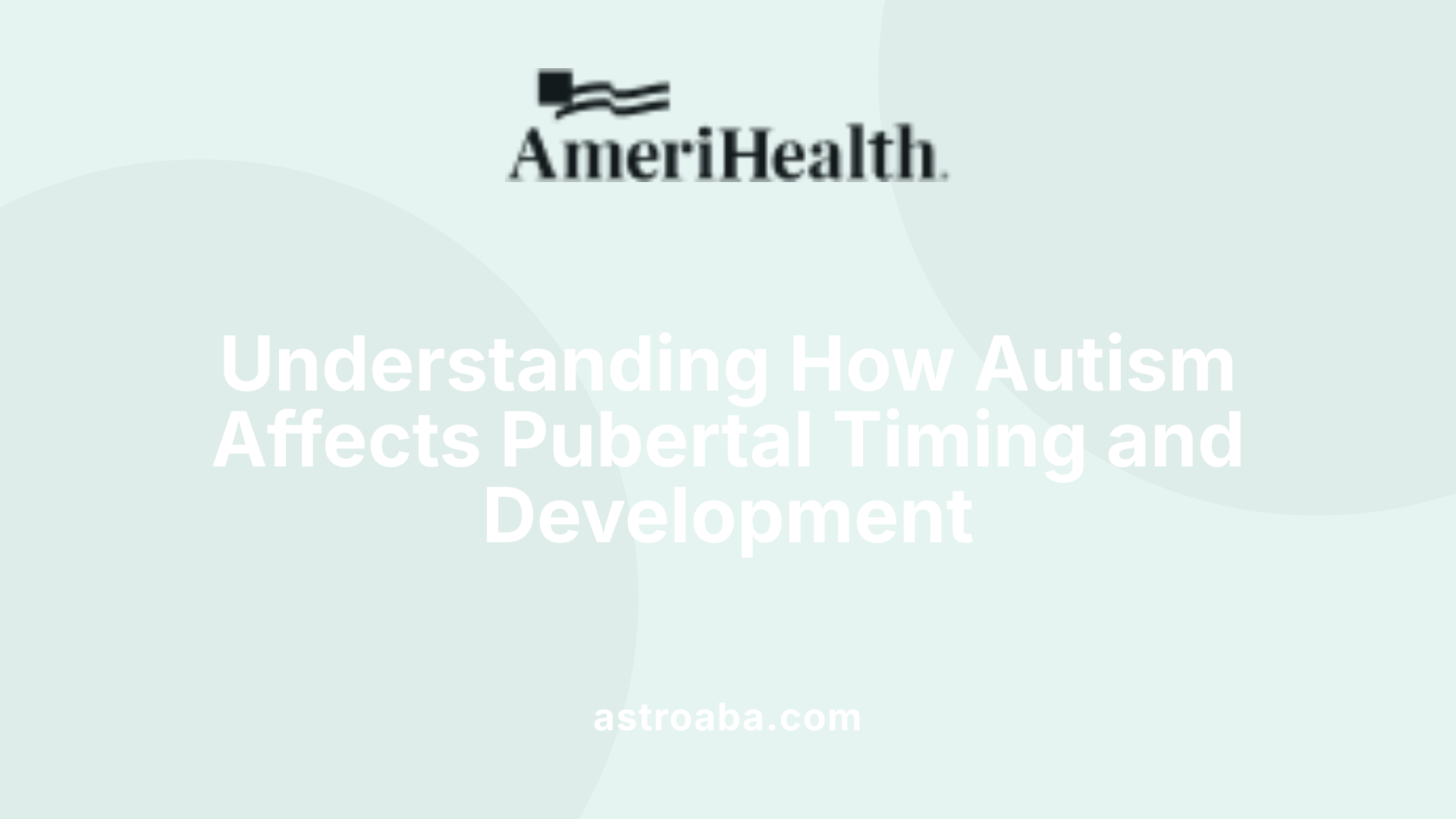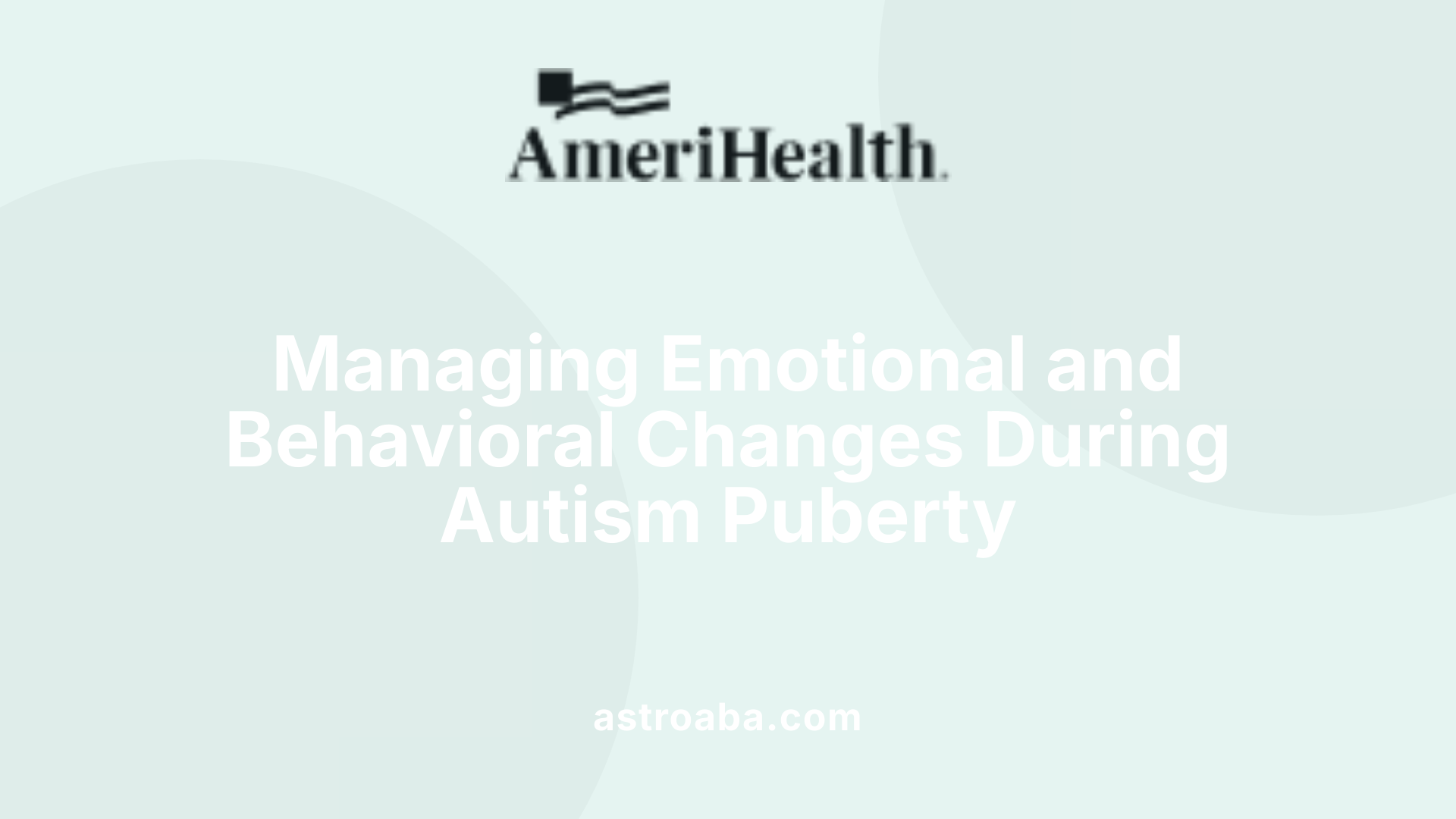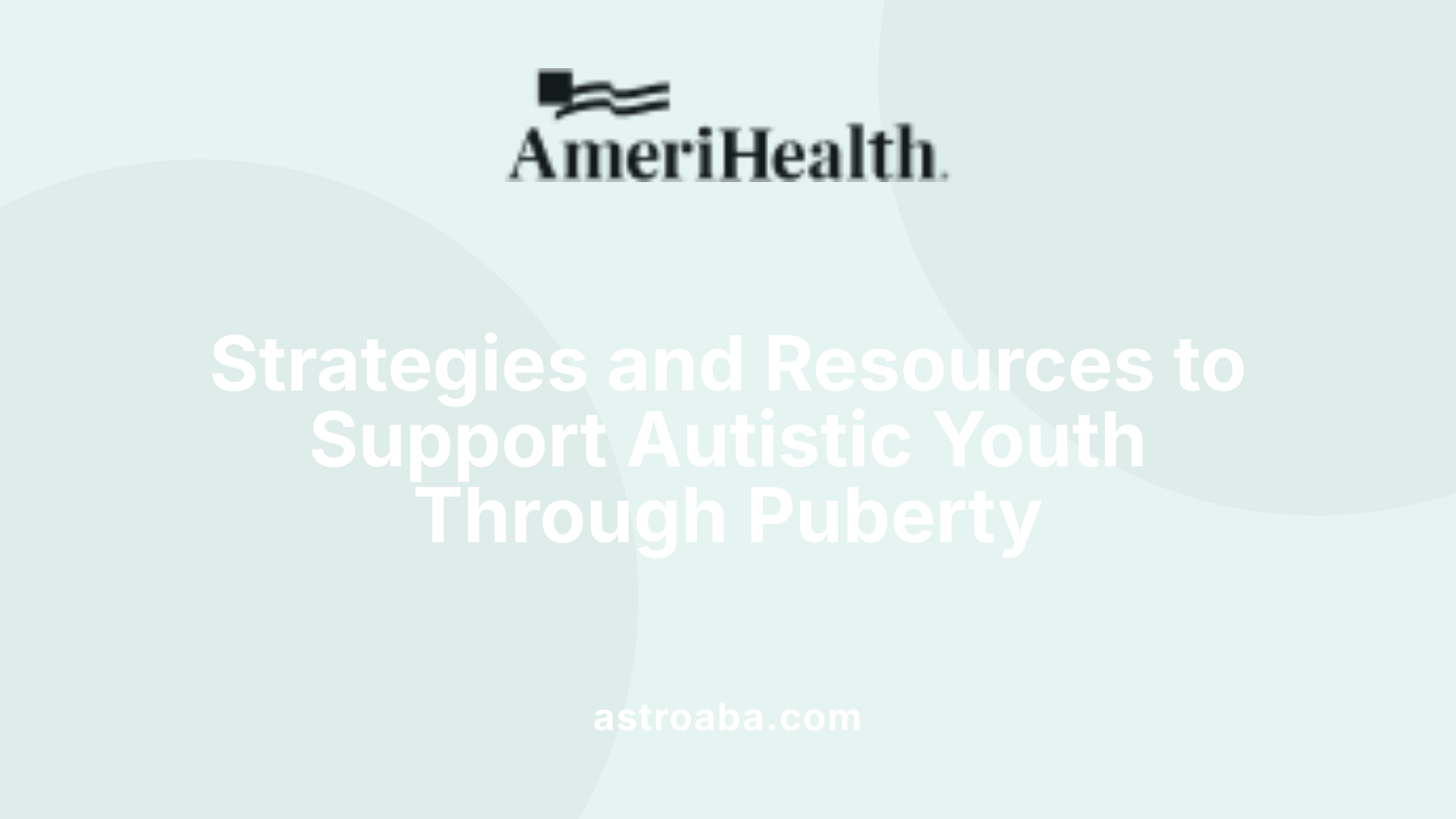Autism and Puberty
Understanding Puberty in Autistic Youth: Challenges and Support Strategies

Navigating the Complex Transition from Childhood to Adulthood
Puberty is a pivotal stage in human development, characterized by significant physical, emotional, and social changes. For autistic children and adolescents, this transition can be particularly challenging due to the sensory sensitivities, social difficulties, and communication differences inherent in autism spectrum disorder (ASD). Recognizing the unique needs of autistic youth during puberty is crucial for families, educators, and healthcare providers. This article explores how autism affects pubertal development, strategies for preparation and support, scientific insights into associated conditions such as precocious puberty, and resources tailored for autistic children and teenagers.
Impact of Autism on Physical Pubertal Development

How does autism affect pubertal development: physical, emotional, and social changes?
Autistic children and adolescents often experience puberty differently from their neurotypical peers. Research shows that autistic girls tend to have an earlier onset of puberty, with signs like breast development and menstruation starting approximately 9.5 months sooner than in non-autistic girls. This early development, known as precocious puberty, is also more common among autistic children overall, with some studies indicating a six to eight times higher risk than non-autistic children.
Physically, autism can influence the timing and progression of pubertal milestones. Boys with autism generally go through puberty at a similar age to their peers, typically starting around age 14, but some may experience a faster pubertal tempo – meaning they go through aspects of puberty more rapidly.
In girls, physical changes include growth spurts, breast development, pubic and underarm hair, and the onset of menstruation. Girls with autism may also face additional challenges such as irregular menstrual cycles, severe acne, or hormonal conditions like polycystic ovary syndrome. Boys experience changes such as increased muscle mass, voice deepening, hair growth on face and body, and development of genitalia, with erections and wet dreams being normal parts of their puberty.
The increased risk of precocious puberty in autistic children can be associated with hormonal shifts that occur earlier in some cases. This early onset can lead to additional health concerns and emotional stress. Many autistic children require early education, visual supports, and clear communication to understand these changes.
Overall, autism influences pubertal progression in multiple ways—biologically, it may lead to earlier or more rapid physical development, and socially and emotionally, it can compound the challenges faced during adolescence. Tailored healthcare, education, and emotional support are therefore essential for helping autistic youth navigate this critical developmental stage.
Emotional and Behavioral Challenges During Puberty in Autism

What behavioral, hormonal, and physiological challenges may individuals with autism face during puberty?
Puberty is a complex stage that can be particularly difficult for children with autism, as it involves profound physical, hormonal, and emotional changes. During this time, autistic adolescents often experience increased anxiety and depression, along with mood swings that can be intense and unpredictable.
One of the hallmark challenges is the rise in emotional distress, which may manifest as aggression, property destruction, or self-injury. These behaviors often stem from difficulty understanding and coping with bodily changes such as voice deepening in boys, menstruation in girls, hair growth, and acne. The hormonal fluctuations that occur during puberty further contribute to emotional volatility, sometimes leading to heightened anxiety and frustration.
Behavioral issues can also intensify, with adolescents experiencing increased frustration due to sensory sensitivities, social misunderstandings, and difficulty expressing themselves. These adolescents might have trouble managing mood swings and may exhibit increased frustration, aggression, or withdrawal. Sleep problems are common as well, often linked to heightened anxiety or difficulty settling down.
Given these challenges, it is essential to support autistic youth through early education on bodily changes, emotional regulation, and social boundaries. Visual supports like social stories, behavioral therapy, and, when necessary, medication assessments can help manage emotional and behavioral difficulties.
In summary, the combination of hormonal changes, physiological developments, and psychological impacts can pose significant hurdles during puberty for individuals with autism. Tailored support plans that include behavioral therapies, emotional support, and clear communication strategies are vital to help them navigate this turbulent period successfully.
More information: For further insights into how puberty impacts behavior and emotion in autistic individuals, search for "Behavioral and emotional challenges in autistic puberty".
Supporting Autistic Children Through Puberty

What strategies and resources can support autistic children through puberty?
Supporting autistic children during this pivotal stage requires a thoughtful, multi-faceted approach. Early education about body changes and social norms helps prepare children for the physical and emotional shifts they will experience.
Visual supports such as social stories, picture charts, and videos are effective tools to explain bodily changes, social expectations, and safety concepts in simple, understandable terms. These tools help reduce confusion and anxiety, allowing children to grasp complex topics like menstruation, erections, and private versus public behavior.
Communication aids, including augmentative and alternative communication (AAC) devices like picture schedules, sign language, or electronic talking devices, assist children with limited verbal skills in expressing feelings and understanding social cues. This is crucial for discussing sensitive topics such as sexuality and personal boundaries.
Collaboration with therapists, educators, and healthcare professionals is essential. Developing personalized plans that include behavioral strategies, social skills training, and emotional support can address specific challenges faced by each child. Behavioral interventions, such as behavior management programs and cognitive-behavioral therapy (CBT), are useful in helping manage mood swings, anxiety, and behavioral issues.
Teaching hygiene, privacy, and safety skills through routine practice and visual supports fosters independence and awareness. Topics like proper bathing, dealing with body odor, and understanding the importance of privacy and body autonomy should be covered early and reinforced regularly.
Addressing emotional well-being and mental health is equally vital. Monitoring for signs of depression or anxiety and referring to mental health professionals when necessary can prevent and treat emotional difficulties. Support from counselors familiar with autism helps children navigate emotional challenges with patience and understanding.
In summary, a comprehensive approach combining visual aids, communication tools, professional collaboration, life skills education, and mental health support creates a nurturing environment that empowers autistic children to manage puberty's physical, emotional, and social demands. This supportive framework not only reduces anxiety but also fosters resilience and healthy development during adolescence.
Educational Strategies and Communication Tools for Puberty Preparation
Preparing autistic children for puberty requires thoughtful use of educational strategies that foster understanding and comfort. Visual aids such as diagrams, social stories, and schedules are highly effective in making complex changes more approachable.
Visual supports like visual schedules help children anticipate daily routines related to hygiene and body care, reducing anxiety by creating predictability. Social stories, which are simple, structured narratives with pictures, can explain physical changes, social boundaries, and safety in a clear, concrete manner. For example, stories can illustrate what happens during menstruation or erections, helping normalize these experiences.
Clear and precise language is vital. Using medically accurate terms in an age-appropriate way helps prevent confusion and promotes understanding. For instance, explaining that erections are normal and involve the body’s biological functions can reassure boys who are learning about these new sensations.
Involving therapists, teachers, and caregivers in the creation of personalized visual supports ensures the information is relevant and tailored to each child's needs. Collaboration allows for the development of social stories and visual tools that consider a child's communication style and cognitive level.
Teaching about physical changes, boundaries, and safety should be done with straightforward language, incorporating visual aids for added clarity. Cover topics like private parts, appropriate boundaries, and the importance of privacy in a sensitive manner.
Overall, integrating visual supports, clear communication, and professional input creates a supportive environment. This helps autistic children approach puberty with confidence, understanding, and a sense of safety, promoting smoother transition and healthier emotional development.
Scientific Research Linking Autism and Puberty Timing

Are there scientific insights into the relationship between autism and puberty, including aspects like precocious puberty?
Recent scientific studies reveal a notable connection between autism spectrum disorder (ASD) and the timing of puberty. Evidence indicates that children with autism are more likely to experience precocious puberty, which refers to the early onset of pubertal changes.
Large-scale research using nationwide health data, such as a Taiwanese study involving over 29,000 children, found that autistic children have an increased risk of developing precocious puberty. The hazard ratio (HR) for this condition in autistic children is around 1.8, meaning they are 80% more likely to experience early puberty compared to non-autistic peers.
Particularly in girls, the trend is more pronounced. Autistic females often start puberty approximately nine months earlier than their non-autistic counterparts. The average age of pubertal onset, including breast development and menstruation, tends to be earlier in girls with autism. This early development can have psychological and social impacts, requiring careful monitoring and support.
The biological, hormonal, and neurological underpinnings of this phenomenon are currently under active investigation. Researchers are exploring sex-specific hormonal profiles, genetic factors, and brain development patterns that might influence both autism and the timing of puberty.
Neurological studies show that brain connectivity changes during puberty could differ in children with autism. These brain network alterations, especially in regions responsible for social, emotional, and hormonal regulation, might play a role in the accelerated or atypical pubertal development observed.
Overall, understanding the link between autism and puberty timing can help healthcare professionals develop better management strategies. It highlights the importance of early identification and tailored support for autistic children going through hormonal and physical changes during adolescence.
Biological, Psychological, and Social Implications of Puberty in Autism
 Pubertal development in autistic individuals involves significant biological changes that mirror those experienced by neurotypical peers. These include growth spurts, development of secondary sexual characteristics such as breast and pubic hair growth, voice deepening in boys, menstruation in girls, and other hormonal shifts. Interestingly, research indicates that autistic girls often experience earlier onset of puberty, including precocious puberty, which can occur before age 8 in girls, and is associated with higher risks of rapid pubertal progression. Moreover, some studies suggest that puberty may increase the frequency of seizures in those with autism, reflecting hormonal and neurological interactions.
Pubertal development in autistic individuals involves significant biological changes that mirror those experienced by neurotypical peers. These include growth spurts, development of secondary sexual characteristics such as breast and pubic hair growth, voice deepening in boys, menstruation in girls, and other hormonal shifts. Interestingly, research indicates that autistic girls often experience earlier onset of puberty, including precocious puberty, which can occur before age 8 in girls, and is associated with higher risks of rapid pubertal progression. Moreover, some studies suggest that puberty may increase the frequency of seizures in those with autism, reflecting hormonal and neurological interactions.
Psychologically, puberty can be a particularly turbulent period for autistic adolescents. Sensory sensitivities and difficulties in emotional regulation often intensify, leading to increased anxiety, depression, and behavioral challenges such as aggression or self-injury. Many autistic teens also struggle to recognize social cues and navigate complex social norms, which can result in feelings of isolation, low self-esteem, and stress about bodily changes and sexuality.
On the social front, adolescents on the spectrum need targeted education about body changes, personal boundaries, and safe social and online behaviors. Lack of appropriate information can lead to misconceptions, vulnerability to exploitation, or inappropriate behaviors like masturbation without understanding privacy rules. Early, reinforced education combined with visual supports, social stories, and behavioral therapies can foster better understanding and coping skills.
The combination of biological, psychological, and social factors underscores the importance of coordinated support from families, educators, and healthcare professionals. Regular check-ins, emotional support, and tailored interventions like cognitive-behavioral therapy (CBT) and behavioral programs help manage emotional distress and promote social skills. Planning ahead for adult life, including vocational and legal preparations, ensures that autistic individuals develop lifelong resilience and adaptive skills.
In summary, puberty’s impact on autistic individuals spans physical, mental, and social domains. Recognizing these interconnected implications allows for better-targeted interventions that support healthy development and foster independence and well-being during this critical life stage.
More Info Search Query: Implications of puberty in autism
Supporting Autistic Youth Through a Transformative Stage
Puberty is a critical and often complex phase for autistic children and adolescents, involving unique physical, emotional, and social challenges. Early education, consistent communication, visual supports, and collaboration with professionals are vital to ensuring a smooth transition. Recognizing the higher risk of precocious puberty and its implications, along with addressing behavioral and mental health concerns, enables tailored interventions that foster confidence, independence, and well-being. With ongoing support from families, educators, and healthcare providers, autistic youth can navigate puberty with resilience, developing essential skills for adulthood while maintaining their unique strengths and needs.
References
- Autism and Puberty - Child Mind Institute
- Autism and puberty
- Lurie Center for Autism: Puberty - Massachusetts General Hospital
- Autism and risk of precocious puberty - ScienceDirect.com
- The Association between Autism Spectrum Disorder and Precocious ...
- Puberty and Your Child with Autism - AbilityPath
- Autism and puberty aggression
Recent articles

The Role of Prompting and Fading in ABA Therapy Programs
Enhancing Autism Interventions Through Systematic Support Reduction

The Role of ABA Therapy in Supporting Community Participation
Enhancing Lives Through Community-Focused ABA Interventions

The Role of ABA Therapy in Encouraging Initiative and Motivation
Unlocking Potential: How ABA Empowers Children to Take Initiative

How ABA Therapy Helps Children Develop Initiation and Motivation
Unlocking Potential: The Power of ABA in Fostering Child Independence

How ABA Therapy Encourages Participation in Cooperative Group Activities
Fostering Social Skills Through ABA Interventions

How ABA Therapy Supports Independent Task Initiation in Children
Empowering Children to Begin with Confidence

How ABA Therapy Helps Children Build Resilience in Challenging Situations
Building Emotional Strength Through ABA Therapy

The Impact of ABA Therapy on Reducing Anxiety in Social Settings
Transforming Social Experiences: How ABA Therapy Eases Autism-Related Anxiety

Strategies for Teaching Self-Monitoring Through ABA
Empowering Independence: Techniques to Foster Self-Monitoring with ABA

The Benefits of Combining ABA with Speech and Language Therapy
Integrating Treatment Approaches to Maximize Developmental Progress

Strategies for Teaching Cooperative Problem-Solving Through ABA
Enhancing Collaborative Skills with ABA: Proven Strategies and Techniques

How ABA Therapy Encourages Independent Participation in Daily Tasks
Empowering Autonomy: How ABA Therapy Builds Independence in Daily Life

Creating an Effective Learning Environment at Home for ABA Therapy
Building a Supportive Home Environment for ABA Success

How ABA Therapy Encourages Following Safety Rules at Home and School
Empowering Children with Autism to Follow Essential Safety Rules

How ABA Therapy Encourages Communication Using Gestures and Signs
Enhancing Social Skills with Targeted Gesture Teaching

Common ABA Therapy Techniques for Reducing Aggression
Innovative Strategies in ABA to Minimize Aggressive Behaviors

How ABA Therapy Encourages Communication Using Gestures and Signs
Unlocking the Power of Gestures and Signs in Autism Therapy

How ABA Therapy Encourages Appropriate Social Greetings
Enhancing Social Skills Through Evidence-Based Interventions

Addressing Social Anxiety Using ABA-Based Techniques
Harnessing ABA to Alleviate Social Anxiety

Famous Politicians With Autism
Celebrating Neurodiversity: Insights into Autism and Notable Figures

How ABA Therapy Can Help with Anxiety in Children with Autism
Unlocking Emotional Well-Being: The Power of ABA in Managing Autism-Related Anxiety

The Impact of ABA Therapy on School Success
Enhancing Educational Outcomes with Systematic Interventions

The Importance of Social Stories in ABA Therapy
Harnessing Social Stories to Enhance Social Skills in Autism Interventions

Mild Autism
Understanding the Nuances of Mild Autism

What Are Functional Behavior Assessments (FBA) in ABA Therapy?
Unlocking the Secrets Behind Behavior: The Power of FBAs in ABA

Early Signs Of Autism In Babies And Kids
Recognizing Early Indicators to Support Developmental Health

How to Find Funding for ABA Therapy Services
Unlocking Funding Opportunities for Autism Treatments

How to Help a Child with Autism Transition to ABA Therapy
Supporting Children Through Transition Phases in ABA Therapy

Do Autistic People Get Injured More?
Examining Injury Risks in Individuals with Autism Spectrum Disorder

How ABA Therapy Can Help with Executive Functioning Challenges
Unlocking Skills: The Impact of ABA on Executive Functioning in Autism

What is the Premack Principle in ABA Therapy?
Unlocking Motivation: The Power of the Premack Principle in ABA Therapy

Low-Functioning Autism
Understanding the Challenges and Supports for Low-Functioning Autism

Low-Functioning Autism
Understanding the Challenges and Supports for Low-Functioning Autism

How ABA Therapy Can Help with Playdates and Social Events
Unlocking Social Success: How ABA Therapy Facilitates Playdates and Community Engagement

How ABA Therapy Can Address Impulse Control Issues
Mastering Behavioral Growth: The Power of ABA in Impulse Control

Book, Movie, and TV Characters on the Autism Spectrum
Enhancing Understanding Through Fictional Portrayals

Book, Movie, and TV Characters on the Autism Spectrum
Enhancing Understanding Through Fictional Portrayals

The Role of Visual Supports in ABA Therapy
Enhancing Autism Interventions with Visual Supports

What Is Pervasive Developmental Disorder
Understanding the Spectrum of Developmental Challenges

How ABA Therapy Helps with Emotional Regulation
Empowering Emotional Resilience in Children with Autism

What is Task Analysis in ABA Therapy?
Unveiling the Foundations of Task Analysis in ABA Therapy

How ABA Therapy Can Improve Play Skills
Unlocking Growth: The Power of ABA in Enhancing Play Skills

Air Pollution and Autism
Unveiling the Environmental Impact on Developing Minds

How ABA Therapy Can Help with Bullying Prevention
Building Respect and Resilience Through ABA

How ABA Therapy Can Be Used to Teach Problem-Solving Strategies
Empowering Individuals with Autism Through Targeted Problem-Solving Skills

Can Autistic People Work?
Unlocking Potential: The Realities of Employment for Autistic Individuals

How ABA Therapy Can Help with Homework and Academics
Empowering Academic Success with ABA Therapy

Common Myths About ABA Therapy Debunked
Unmasking Autism Treatment: The Truth About ABA Therapy

Does Aluminum Cause Autism?
Unraveling the Link: Aluminum and Autism Spectrum Disorder

How ABA Therapy Can Support Emotional Expression and Understanding
Unlocking Emotional Growth in Autism Through ABA Therapy

The Role of ABA Therapy in Helping Children Learn Road Safety
Empowering Safe Journeys: How ABA Therapy Fosters Road Safety Skills in Children

The Role of Group ABA Therapy in Social Development
Enhancing Social Skills Through Collective Strategies

What Is Autistic Burnout?
Understanding the Hidden Struggle of Autistic Burnout

How Do You Get An Autistic Child To Keep Their Shoes On?
Mastering Comfort and Compliance with Shoes for Autistic Children

The Role of ABA Therapy in Addressing Food Aversions and Picky Eating
Transforming Mealtimes: How ABA Therapy Supports Children with Autism

How ABA Therapy Can Assist in Reducing Perfectionism and Anxiety
Harnessing Behavioral Science to Ease Perfectionism and Anxiety

What Is Defeat Autism Now?
Unveiling the Roots and Realities of the DAN Movement

How ABA Therapy Can Help Children Develop Conflict Resolution Skills
Building Bridges: Empowering Children with Conflict Resolution Skills through ABA

OCD vs. Autism
Unraveling the Complex Relationship Between OCD and Autism

Temper Tantrums A Sign Of Autism
Understanding the Complex Relationship Between Temper Tantrums and Autism Spectrum Disorder

How to Pass the BCBA Exam
Your Ultimate Guide to Success in the BCBA Exam

Autism and Addiction's Close Connection
Unraveling the Complex Interplay Between Autism and Substance Use

Autism Facial Expressions
Decoding Emotions: The Complex World of Facial Expressions in Autism

How ABA Therapy Can Help Reduce Anxiety Around Doctor and Dentist Visits
Transforming Medical Experiences for Children with Autism

How ABA Therapy Can Help with Navigating Social Media Responsibly
Empowering Safe Online Engagement for Children with Autism through ABA

How to Choose an Autism Charity
Navigating the Spectrum of Support: A Guide to Selecting the Right Autism Charity

What is Precision Teaching in ABA Therapy?
Harnessing Data-Driven Strategies for Skill Mastery

Autism and Obesity
Understanding the Overlap: Autism and the Rising Concern of Obesity

Individualized Education Programs (IEPs) for Autism
Supporting Success: A Comprehensive Guide to IEPs for Children with Autism

How to Integrate ABA Therapy into Everyday Routines
Transforming Daily Life with ABA Strategies

What is Shaping in ABA Therapy?
Understanding the Core of Behavior Shaping in Autism Interventions

Autism vs. ADHD
Understanding the Distinction and Overlap of Neurodevelopmental Disorders

Is RBT Certification Worth It?
Unveiling the Value of RBT Certification in the Field of ABA

How Negative Reinforcement Works in ABA Therapy
Unlocking the Power of Negative Reinforcement in Behavioral Therapy

How to Advocate for ABA Therapy Services in Schools
Navigating Advocacy for School-Based ABA Therapy

How ABA Therapy Can Address Impulsivity in Children
Transforming Child Behavior: The Power of ABA Therapy Against Impulsivity

Understanding the Different Types of ABA Therapy Programs
Exploring the Spectrum of ABA Therapy Approaches

How ABA Therapy Can Address Regression in Autism
Understanding Regressive Autism and the Role of ABA Therapy

High Functioning Autism And Anger
Understanding Emotional Challenges in High-Functioning Autism

Autism and Puberty
Understanding Puberty in Autistic Youth: Challenges and Support Strategies

Challenging Autism Behavior Problems
Navigating the Complex Landscape of Autism-Related Behavioral Challenges

How ABA Therapy Can Help with Sleep Problems
Transforming Bedtime Routines with Evidence-Based Approaches

How ABA Therapy Can Help Improve Cooperation and Compliance
Fostering Respectful Engagement: The Role of ABA in Enhancing Cooperation and Compliance

Eating Disorders And Autism
Unraveling the Complex Relationship Between Autism and Eating Disorders

How Schedules of Reinforcement Work in ABA Therapy
Mastering Reinforcement Patterns to Foster Behavior Change

How to Incorporate ABA Therapy into a Homeschooling Program
Transforming Homeschooling with Evidence-Based Strategies

What Are the Most Common Misconceptions About ABA Therapy?
Unveiling the Truth Behind ABA Therapy: Myths vs. Facts

What is Demand Fading in ABA Therapy?
Demystifying Demand Fading in ABA Therapy

What Are ABA Assessments and How Do They Work?
Understanding the Foundations of ABA Assessments

What is an AAC Device for Autism?
Unlocking Communication: The Power of AAC Devices for Autism

How ABA Therapy Can Help Children Understand and Express Emotions
Enhancing Emotional Understanding Through Evidence-Based Interventions

How To Prevent Autism
Emerging Strategies to Reduce Autism Risk in Children

How ABA Therapy Can Improve Verbal and Nonverbal Communication
Unlocking Communication: The Power of ABA Therapy for Children with Autism

Natural Environment Teaching (NET): How It Helps with Skill Generalization
Unlocking Practical Learning in Natural Settings

What Is Play Therapy For Autism?
Unlocking the Potential of Play in Autism Therapy

How ABA Therapy Can Improve Fine and Gross Motor Skills
Enhancing Movement and Independence Through ABA Strategies

Calming Strategies For Kids With Autism
Understanding and Supporting Calmness in Children with Autism

Autism Evaluation
Comprehensive Insights into Autism Assessment and Diagnosis

How to Support Your Child's ABA Therapy at Home
Empowering Your Child’s Development at Home with ABA Support

Autism Prevalence Increases in Arizona
Rising Autism Rates Signal Changing Landscape in Arizona

